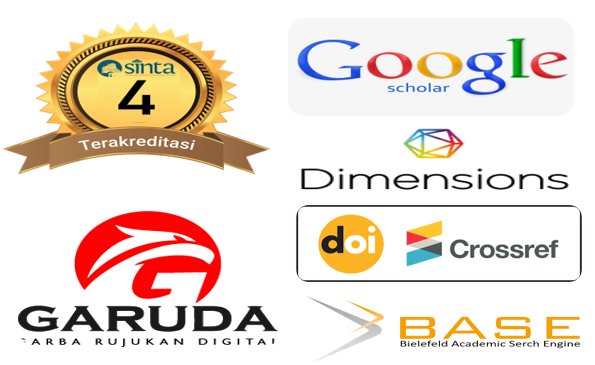The students’ perspectives of platforms used in virtual learning environment: a survey study in COVID-19 pandemic
Abstract
COVID-19 has been the pandemic in Indonesia since March 2020. Drastically, it impacts on educational segment; therefore, the platforms of digital tools are able to be the best alternative way to overwhelm this issue and to strengthen the material delivery conducted by educational institution including universities. They can be beneficial tools in COVID-19 pandemic condition as teachers’ assistance. Due to these issues, this study was conducted to determine students’ perspective on the implementation of platforms in virtual learning environment during Covid-19 pandemic. This study involved 105 participants of the sixth semester students of English department of Universitas Pamulang. To obtain the data, the writer distributed a survey consisting 3 major questions (the platform reference, the advantages and the challenges); the students handed the reflective notes in to all questions related to the implementation of virtual learning in COVID-19 pandemic situation. The findings revealed that the students prefer having screen recording in learning activity (38.10%), Google Meeting (28.57%), Kahoot (19.04%), and Ed Puzzle (14.29%). Furthermore, the advantages of the platforms are time flexibility, effective platforms, less quota, interaction, fun application, the mastery of grammar; however, the challenges are monotonous activity, the students’ boredom, difficult to create an account, poor responses, poor internet connection and inequivalent schedule.
Keywords
References
Amaliah. (2020). Implementation of Edpuzzle to Improve Students’ Analytical Thinking Skill in Narrative Text. Jurnal Ilmu Bahasa dan Sastra Program Studi Sastra Inggris Universitas Trunojoyo, 14 (1). April 2020
Budiati. (2017). ICT (Information and communication technology) Use: Kahoot program for English students’ learning booster. The 1st education and language international conference proceedings centre for international language development of Unissula pp. 178-188.
Dillenbourg, P. (2000) Virtual Learning Environments. Retrieved on October, 2020 from http://tecfa.unige.ch/tecfa/publicat/dil-papers-2/Dil.7.5.18.pdf
Ferriman, J. (2019). Characteristics of Virtual Classroom. Retrieved on October 16, 2020 from https://www.learndash.com/characteristics-of-a-virtual-classroom/.
Haryati, H. (2017). EFL Students’ Perspectives of Applying CALL through Project-Based Learning. In UICELL Conference Proceeding (No. 1).
Looper, C.D & Cohen, S. (2020). We compared Google Meet and Zoom to see which is better for remote working and learning — and Zoom is the more comprehensive video conferencing tool. Retrieved on November, 2020 from https://www.businessinsider.com/google-meet-vs-zoom?r=US&IR=T
Mansur, M & Fadhilawati, D. (2019). Applying Kahoot to Improve the Senior High School Students’ Vocabulary Achievement. VELES Voice of English Language Education Society 3(2):164. Retrieved on November 2020 from https://www.researchgate.net/publication/336894905_Applying_Kahoot_to_Improve_the_Senior_High_School_Students'_Vocabulary_Achievement
Pannen.P (1999). Pengertian Sistem Pendidikan Terbuka dan Jarak Jauh. Jakarta: Universitas Terbuka.
Rajab, M. (2020). Pendidikan di tengah pusaran wabah corona detikNews. Retrieved on October 1, 2020 from https://news.detik.com/kolom/d-4945590/pendidikan-di-tengah-pusaran-wabah-corona
Reimers, F et al. (2020). Supporting the continuation of teaching and learning during the COVID-19 Pandemic. Retrieved on October 17, 2020 from oecd.org/education/Supporting-the-continuation-of-teaching-and-learning-during-the-COVID-19-pandemic.pdf.
Scagnoli, N.I., Choo, J. and Tian, J. (2019). Students' insights on the use of video lectures in online classes. Br J Educ Technol, 50: 399-414. doi:10.1111/bjet.12572
Setyawan, A, et al. (2020). Effects of the Google Meet Assisted Method of Learning on Building Student Knowledge and Learning Outcomes. Universal Journal of Educational Research 8(9):3924-3936. Retrieved on November 2020, from https://www.researchgate.net/publication/345332768_Effects_of_the_Google_Meet_Assisted_Method_of_Learning_on_Building_Student_Knowledge_and_Learning_Outcomes
Shah, M. (2020). Google Meet is a Fantastic Communication Software. Retrieved on November, 2020 from https://www.trustradius.com/products/google-meet/reviews?qs=pros-and-cons
Stake, R. E. (2010). Qualitative Research. London: The Guilford Press.
Sugiyono. (2018). Metode Penelitian Kuantitatif, Kualitatif, R&D. Bandung: Alfabeta.
Sujarwo, et al. (2020). An Analysis of University Students’ Perspective on Online
Learning in the Midst of Covid-19 Pandemic. Jurnal Pendidikan dan Pengajaran, Vol. 53 (2), 125-137.
Suminar, A. (2020). Dampak covid-19 terhadap ekonomi global 2020. Retrieved on October from https://www.suarasurabaya.net/ekonomibisnis/2020/dampak-covid-19-terhadap-ekonomi-global-2020/ 2020 from Surabaya.
Thomson, A., Brodgstock, R., & Willems, C. (2014). “Teachers flipping out” beyond the online lecture: Maximizing the educational potential of video. Journal of learning design, (7 (3), 67-78. Retrieved September, 2020 from https://eric.ed.gov/?=EJ1048777 Crossref.
Torat, B. (2000). Computer-assisted language learning: An overview. Retrieved September 15, 2017, from http://web.warwick.ac.uk/CELTE/tr/ovCALL/booklet1.html
DOI: 10.30595/lks.v15i1.9308
Copyright (c) 2021 Leksika: Jurnal Bahasa, Sastra dan Pengajarannya

This work is licensed under a Creative Commons Attribution 4.0 International License.
ISSN: 2620-4037

